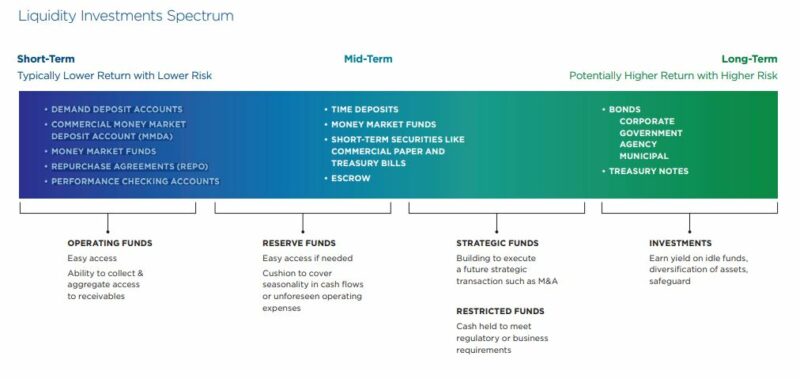Whether your business is building capital or in a growth cycle, effectively managing excess liquidity is vital to a successful cash management strategy. Many solutions are available to meet both short- and long-term operating and investment needs, but it’s important to start with a broad view of business goals and the tools that can support them.
Because liquidity requirements are complex and variable based on your business, optimizing excess cash requires a mix of both traditional deposit accounts and longer-term investment models. Take advantage of savings and investment resources to help your company maximize and stabilize earnings across business cycles.
Identify opportunities to capitalize on excess funds
The first step in an effective liquidity management plan is understanding how much cash you need on hand to cover basic operating expenses like rent, payroll and insurance payments. How do these recurring expenses line up with typical income flows? Are there periods of time when you’ll likely have more available cash than you need to cover your payments?
By taking a closer look at cash flow patterns, you’ll be able to identify opportunities to put excess liquidity to work. Even if your cash flow is tight and you need quick access to funds on a regular basis, there are strategies for short-return timeline requirements, including leveraging some of the below account types. These accounts provide quick access to funds, while also providing some benefits:
- Demand deposit accounts: Operating accounts that generate earning credits that can offset monthly service charges.
- Performance checking accounts: Earn interest on your funds, but with limitations on the amount of monthly withdrawals
- Money market accounts: Earn interest while investing in non-FDIC-insured, off-balance sheet investments
- Repurchase agreements (repos): Earn interest while investing in a lower-risk option
Use segmented goals to build a comprehensive plan
Building a cash optimization plan starts with an understanding of business operations and goals—and their timeframes. Business expenses can be broken into four segments: operating, reserve, strategic and restricted. Except for restricted cash, which is ineligible for certain investment products and must be set aside, each segment corresponds to a period of time on the liquidity spectrum.

The liquidity spectrum begins with short-term opportunities that are typically lower return with lower risk like demand deposit accounts, as noted above.
Mid-term opportunities include time deposits, money market funds, escrow and short-term securities like commercial paper and treasury bills.
Long-term opportunities have a potentially higher return with higher risk like bonds (corporate, government, agency and municipal) and treasury notes. Operating funds are best to invest in short-term opportunities, reserve funds can be invested in short- or mid-term opportunities, strategic and restricted funds can be invested in both mid- and long-term opportunities.
Once you’ve examined the timing and amounts of regular payments and income, you can work with your banker to create a liquidity optimization plan. Using these short-, mid- and long-term categories, you can build a custom plan that includes both savings and investment accounts to optimize earnings while maintaining access to the cash you need.
Consider the impact of current market conditions
A successful liquidity management strategy depends not only on identifying the timing of specific cash needs, but also your firm’s appetite for risk. The goal would be to engage an integrated financial team to help distribute risk both on- and off-balance sheet to ensure funds are put to the best use while still maintaining access to day-to-day capital requirements.
While cash to cover operating costs should be kept in short-term, low-risk products, long-term strategic capital may be able to endure greater fluctuations. Accordingly, options are available to accommodate a variety of risk profiles, ranging from traditional bank depository products to complex capital markets investment options. Whether the return is higher on the banking or capital markets side is determined by market conditions and the corresponding rate environment.
Leverage your bank for long-term support
Your relationship with your banker plays an important role in building a comprehensive, long-term investment plan. Not only can your banker help you choose a short-term savings model that aligns with your cash flow fluctuations, but they can also help you create a long-term approach. Building a liquidity management strategy that yields consistent returns requires a deep understanding of your business’ goals, special requirements and risk appetite.
Working with the right financial team gives you a team of experts who know your business well enough to create a custom plan and can evolve that plan as your needs become increasingly sophisticated.
If you are interested in learning more about how UMB can help your business and your financial future, visit our website.





